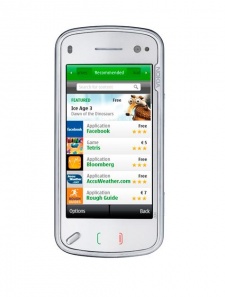You certainly can't fault Nokia for ambition. When its Ovi Store went live this morning, the company said it supported 50 individual handset models, and upwards of 50 million people would be able to use it.
Big numbers, although the latter only represents potential a bit like saying channel Dave has a notional audience of everyone with a digital TV set-top box. Just because 50 million people CAN access Ovi Store, doesn't mean they WILL.
Even so, launching with such wide support on day one is an impressive feat, and a sign of how much Nokia needs Ovi Store to be a success. It's a calculated and utterly necessary attempt to wrestle back the initiative from Apple, and reposition Nokia for the years ahead.
Can you imagine how Nokia's top bods must have been fuming in recent months, as Apple's App Store smashed through download milestone after download milestone?
You've been able to download applications to Nokia handsets for years now, from operator portals, D2C services and even Nokia itself. Its Download client has been around for longer and with a much vaster install base than the App Store yet through a combination of slick UI and clever marketing, Apple as near-as-dammit owns the mobile apps space or is perceived to by consumers.
(As a side-note, you would hope the App Store's success is causing a few blushes within operators too, who infamously struggled to get their heads around the idea of selling non-game applications on their portals until Apple came along).
But back to Ovi Store. Nokia remains the largest handset maker in the world, so Ovi Store is its big chance to prove that it can get those tens and hundreds of millions of Nokia customers downloading apps and games.
Like it or not, it'll be judged against the App Store too. People will be watching to see how quickly Ovi Store reaches a billion downloads, for example, and whether that's quicker than Apple did.
People will compare the two stores' billing mechanisms too Apple stores users' credit card details to make app purchasing super-quick and easy, while Nokia has a combination of carrier billing and credit card payments with the former only available in seven countries at launch.
On the upside, people will also compare the two stores' recommendation and discovery tools an area Nokia may have an edge in if and only if its 'social location' recommendations really do serve up relevant and high-quality apps to users based on their buying habits, friends and location.
The size of the bet that Nokia is making on Ovi Store can be seen in the way it's sidelining some of its own initiatives like Ovi Share in favour of the new store. It's widely expected in the mobile games industry that the N-Gage games platform will be folded into it at some stage too.
Nokia has made enough mis-steps on the content side of things in recent years to make developers cautiously optimistic about Ovi Store's potential, rather than wildly celebratory.
For varying reasons, other recent app store launches from Google and BlackBerry have shown that there is no shortage of pitfalls for anyone trying to match Apple's success.
But make no mistake: Ovi Store needs to be a success for developers and publishers, but most of all for Nokia itself.
Analysis: Why Nokia's Ovi Store is a big deal
And why it will be judged against the iPhone App Store





















